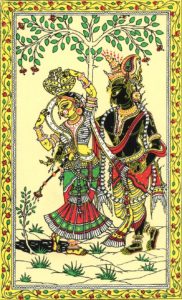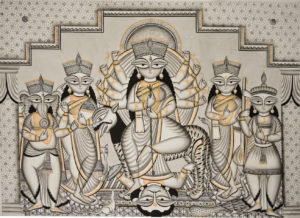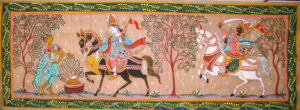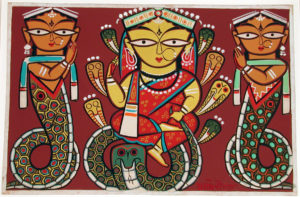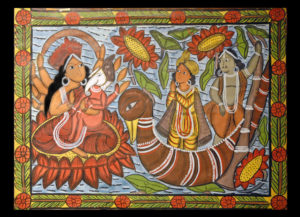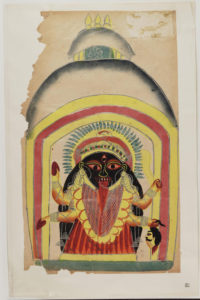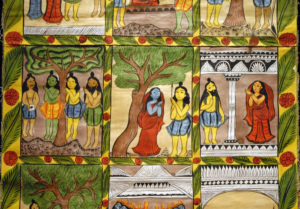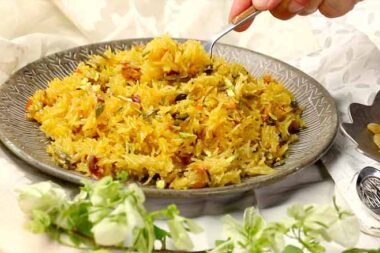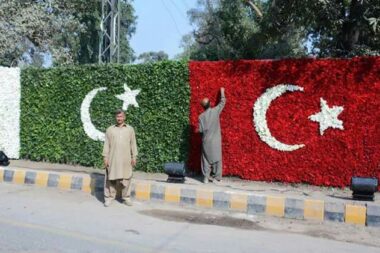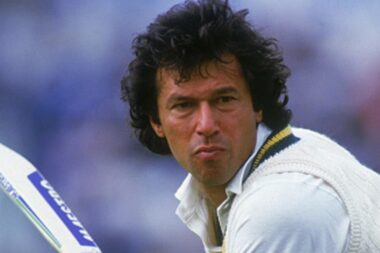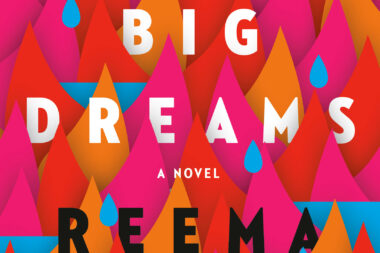“If art is escape then this is the one, if art is entertainment then this is the one, if art is education then this is the one and if art is enlightenment then this has to be the one”, said an adept Pattachitra painter while he was lost in recreating the magic of a rustic folklore on the surface of a raw silk fabric popularly called “tussar”. These wise words summarize the saga of Pattachitra painting.
Pattachitra Painting: Colors, Contours and Concepts
In Sanskrit, “Patta” means cloth and “Chitra” means picture which when put together collectively means ‘pictures made on cloth’. Pattachitra painting originated in Raghurajpur, “the artist’s village”, located in the eastern coast of Odisha in India. It is a unique kind of painting that is essentially organic, eco-friendly and charged with the flavors of culture.
The Pattachitra artists, addressed as Chitrakars, work in a very uncommon fashion. According to thehindu.com the Patta artists “reach for the twigs…stockpile the different leaves and vegetables and grind them into separate pastes. In hollowed out coconut shells, the artist mixes the colored pastes with the saps of trees” to prepare the palate for their art and then begins the eventful journey of this 4th century old traditional form of painting.
The color schemes created from a unique blend of pure natural ingredients are generally bold hues of earthen colors like orange, red, yellow, blue etc. These vibrant shades are developed from pure vegetable and mineral colors, for instance reds from ‘Hingula’, blues from ‘Ramaraja’ indigo, blacks from burnt coconut shells, whites from processed conch shells, etc. to name a few interesting ones. Even the brushes were prepared from the hair of domestic animals and feathers of birds. When this crude, conventional and immensely natural paraphernalia comes together in creating the final rendition of Pattachitra painting, the result is invariably fascinating and mesmerizing. The beauty that organic elements create transcends geographical limitations and becomes a timeless piece of art that speaks to everyone’s aesthetics, from lay people to choosy connoisseurs.
Pattachitra paintings are far from abstract and are particularly renowned for being thematic and narrative. The most famous subject matters of the art are the Vaisnav paintings and the Jagannath paintings. The themes of Vaishnav paintings are purely derived from the age of Lord Krishna, his relationship with Radha, his camaraderie with quirky gopis, Meera’s devotion towards him, the ten incarnations of Vishnu from Gita Govinda, etc. On the other hand, the concepts of Jagannath Paintings revolve primarily around the holy Trinity of Hindu religion, Lord Jagannath, Balabhadra, Subhadra. Pattachitra painting was originally inspired by the rich Jagannath culture and the vast repository of events and activities associated with it.
It is owing to this initial religious inspiration that Pattachitra took birth in Puri’s Raghurajpur, a village which lies in close proximity to the Jagannath and the Gundicha Temples. It could be said that Pattachitra paintings that depict the tales of the Holy trio like the Rath Yatra (The Car Festival), Bahuda Yatra, the various ‘Vesas’ of the Trinity God, Chandan Yatra, etc. are the most ancient ones.
In addition to these, the subject matters of Pattachitra vary from the mythologies of Ramayana and Mahabharata, the legendary Hindu epics to anthropological subjects like motifs of sculptures, monuments, temples and edifices (Jagannath Temple, Konark Sun Temple), to the more dramatic ones like depiction of cultural dance forms, for example Gotipua dance and Odissi dance in which dancers display an array of emotions through explicit expressions.
Moreover, the gorgeous flora and fauna of India which was once replete with rare botanical and zoological species are also recreated in the paintings of Patta artists. Therefore, brilliant paintings of indigenous flowers, plants, trees and animals are very popular themes of Patta art.
Since these subjects were picked from the richest and the most glorious aspect of Indian culture, they were infused with the strength of histories that could only be shouldered by extraordinary surfaces. It is owing to this grandeur of the Pattachitra concepts that the fabric of Tussar Silk was used in depiction of the art. Tussar is raw, real and classic. It is gold-tinted and emanates a sandalwood shine from its body that is deemed ideal by the Chitrakars to immortalize the beauty of Indian myths, mythologies and religion.
Further, Pattachitra painting is also done on palm leaves which is known as “Tala Patachitra” or Palm engraving art. In Palm Leaf paintings, columns of rectangular palm leaves are sown together to create a book-like canvas, each piece carrying a small extract of the large story. Such paintings are very intricate, nuanced and done with enormous amount of precision. The finished product, needless to say, is a proof of the pain, handwork and responsibility that have been invested into them.
Pattachitra Products
Traditional Pattachitra Paintings are brought into life on borders of silk sarees, dupattas, shawls, wall hangings, wooden frames of mirrors, terracotta pots and décor pieces, mementos, folders, fusion clothes and accessories like kurtis, stoles, skirts, bags, etc. The spaces are, however, not limited to the aforesaid ones. Modern times have extended the reach of this art form and tried to capture hints of Patta paintings in bag packs, blouses, book covers, serving trays, wall papers, bed sheets, vases, table covers, cushions, etc. and much more.
Products of Pattachitra paintings are immensely revered by people and treated as heirloom pieces. Owning any sort of thing with Pattachitra paintings on them is a sign of class and culture-sensitivity.
Pattachitra: Beyond Time and Space
Pattachitra Paintings, which carry enormous amounts of passion and labor have grabbed eyeballs across globe and have risen far above their borders. Although native to the East, Patta arts have gained an international repute over time and are viewed I very high esteem in the West. Commercial markets are a proof of Westerners going crazy over them and purchasing Pattachitra sarees and décor pieces in large quantities.
Pattachitra Painting, like many other fascinating art forms of Odisha, India, is yet another evidence of the old, deep-rooted and layered past of the East that has sheets of stories buried in its soils. Any art form that attempts to unravel the engraved and bring the lost into life always transcends the limitations of time and space. Pattachitra Painting is one such art form that sings unheard songs and speaks unsaid tales through the universal medium of colors. It is probably because of this, Pattachitra has transcended wired borders and become timeless and ageless.

